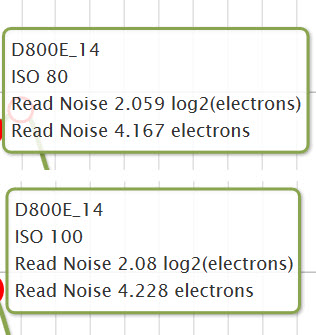Because the ISO range is *supposed to be* analog gain and the expanded range is *supposed to be* digital gain/manipulation... that's the way it's always been, that's the way it is with most of their other cameras. But direct testing (not by me) has shown that it is not true for the D8xx. The D8xx sensor's ISO is 200. Analog trimming gives 100, and analog amplification goes to 1000. Everything else is digital manipulation... With the D8xx (and probably others) what they are essentially saying is "useful range" vs useless.
Does this really matter? Maybe; and maybe not. But it is quite possible that you can get equivalent or even *better* results by doing the digital manipulation yourself... at least it gives you some control over "how" it's done.
sRAw is worse than 12bit compressed NEF and the same size... why would you want to use it?
Right, in camera noise reduction applied to raw files? That's a good thing?
Well, it's only one better than the D800/E and I would find it limiting at times ("fast moving" means a whole different thing when talking small birds in flight). Plus, if you're using DX mode you might as well be using a DX camera... the D7000 does the same 6fps (w/grip) and delivers the same image as my D800 (w/grip) in DX mode.
Because of all of the things I've listed... it's a more demanding camera to use well. It requires better technique, lenses, etc to get the performance from it. And it doesn't *always* outperform other cameras even when used optimally. If I were choosing what *I* think would be a great general purpose camera it would probably be something like a used D700 in the Nikon line. VERY similar performance in many/most situations, easier to use well, higher frame rate, less demanding of lenses, cheap.
My ideal GP camera hasn't been made... but they came real close w/ the Df. If I were buying new, it would have to be a serious contender even though there's a lot about it I don't particularly like (styling/handling). I would probably choose one over the D8xx.


 (Photoshop's Help>About plug-in>Camera Raw shows version 8.6.0.250).
(Photoshop's Help>About plug-in>Camera Raw shows version 8.6.0.250).